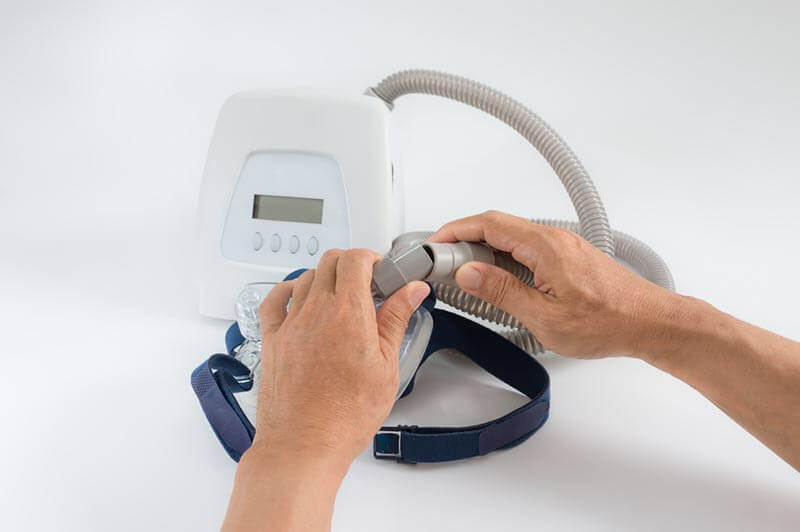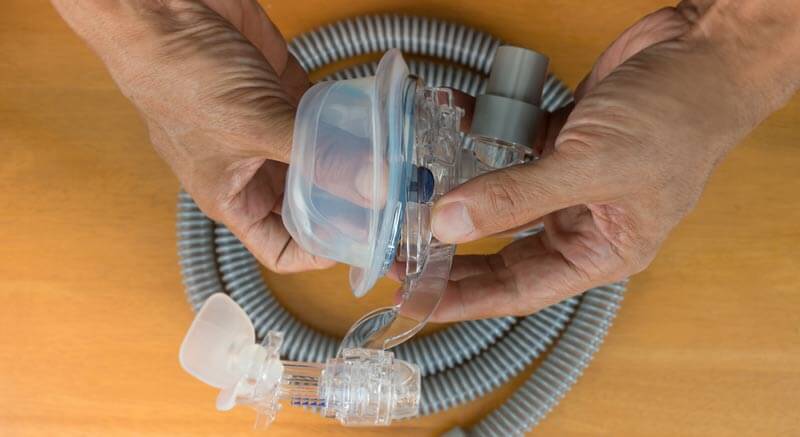Learning that you have sleep apnea is usually overwhelming enough even without all the information you will need to obtain in order to combat this potentially life-threatening condition. After receiving the diagnosis, patients are usually sent to a private provider of medical equipment to get their CPAP machine and associated items.
Your provider should give you all the necessary instructions on how to clean your equipment. In case they don’t – or if you want to learn more – this guide will tell you all you need to know about maintaining your CPAP device (and health) without having to use expensive sanitizers and other unnecessary solutions.

The Dangers Of Not Cleaning Your CPAP Device
Your CPAP equipment must be kept clean at all times since you’re directly breathing the air circulating through the machine. The air will be filtered and humidified, but you should still keep the machine as clean as possible.
Not cleaning your CPAP device can leave you exposed to many dangers or result in potential problems, including:
- Mold exposure
- Bacteria exposure
- Allergy symptoms
- Musty or foul odor
- Increased risk of pneumonia or sinus infections
- Premature equipment breakdown
- Mineralization within the equipment
Things To Avoid When Cleaning You CPAP Mask
CPAP cleaning guides you can find online often recommend cleaning solutions that are harmful to your equipment and health. In order to avoid any potential problems, you should never use these when cleaning your CPAP equipment:
- Antibacterial wipes and soaps
- Vinegar
- Ammonia
- Clorox Bleach
- Alcohol
- Chlorine
- Moisturizers and lotions
- Scented soaps
- Oil-based products
- Hand sanitizers
These products will shorten the lifespan of your equipment and they can also cause allergic reactions. To get the most out of your CPAP mechanism, you should keep it away from direct sunlight to prevent the damage, distortion, and discoloration of its parts.
All manufacturers recommend using only distilled water in the humidifier. Using tap water will create a buildup in the humidifier’s reservoir. In order to remove the mineral scale, you can soak the entire reservoir in white vinegar. This is the only case when vinegar can be used to harmlessly clean your device.
CPAP Cleaning Supplies
All you’ll ever need to clean your CPAP device thoroughly is a soft cloth, warm water, dish soap, and a small sink, basin or tub. People usually use a towel to wipe the components after cleaning them, but we recommend air-drying them. Although heavily advertised, things like SoClean sanitizer device or CPAP cleaner are not really necessary to keep your CPAP clean. These devices use ultraviolet light or ozone to clean your equipment and are usually sold for hundreds of dollars. They are also not covered by your insurance.
These devices do provide a somewhat higher level of cleanliness and safety, but you can get by without them if you can’t fit them into your budget.

How Often Should You Clean Your CPAP Equipment?
CPAP equipment has a lot of different parts, which all require different cleaning regimens. Some of them need to be cleaned on a daily basis while others require weekly/monthly cleaning. In order to provide you with a comprehensive and easy-to-follow cleaning guide, we’ll separate all components into different categories based on the recommended cleaning frequency.
Daily Cleaning
These components need to be cleaned every single day for optimal functioning and health protection:
- Mask and cushion – Clean your CPAP mask and potential cushioning only with warm water and mild soap. You can use Ivory, Dove (unscented) or even baby shampoo. Rinse the mask and cushion and let them air-dry.
- Tubing – Remove the CPAP tubing from your CPAP machine and mask before cleaning. Use the same materials and cleaning steps as with the mask and cushion.
- Humidifier – Empty your humidifier before cleaning and let it air-dry. Change the water. Always use distilled water to avoid the build-up of mineral deposits.
Weekly Cleaning
The components that require weekly cleaning include:
- Non-disposable (gray/black) filters – Simply remove these filters, clean them with warm soapy water, rinse, allow to air-dry, and reinstall.
- Headgear – Identical cleaning procedure.
- Machine – The machine itself should only be wiped with a soft, damp cloth.
- Humidifier – Although you should change the water in the humidifier every single day, you should also rinse it with white vinegar once a week to prevent mold growth. Rinse only with distilled or sterile water.
Monthly Cleaning
This part doesn’t include any cleaning per se. Namely, you should replace the disposable filters (white or white and blue) every month. Never wash these filters and place them back in the machine. They are designed to be discarded after a while since their filtration breaks down with use, causing them to lose effectiveness.
If you don’t wash your non-disposable filters or change the disposable filters regularly, the dirt build-up will cause the machine to overcompensate for the reduced airflow. This extra work will cause the operating temperature of the unit to rise significantly, which increases its possibility of failure.
Additional Tips To Keep Your CPAP Equipment Clean
We hope we painted a pretty good picture of how important it is to keep your CPAP equipment clean. Whatever might be growing inside it, you will be breathing it, so here are some additional tips and recommendations:
- If you’ve been sick recently, you should clean your equipment more often.
- Different manufacturers recommend different cleaning procedures, so make sure to follow the instructions of your equipment provider to the letter.
- Avoid using any cleaning solutions and perfumes that can irritate your lungs and make you sick.
- Never clean your equipment in a washing machine or dishwasher to avoid potential damage.
Bottom Line
Sleep apnea is a very serious condition, but we can lessen its impact or even cure it completely with dedicated therapy solutions. CPAP therapy carries a minimal amount of risk – unless you fail to keep your equipment as clean as possible. This doesn’t mean you have to spend absurd amounts of money on highly advertised sanitizers and cleaners. Simply follow the instructions provided in this guide to ensure long-term health and optimal benefits from your prescribed therapy.